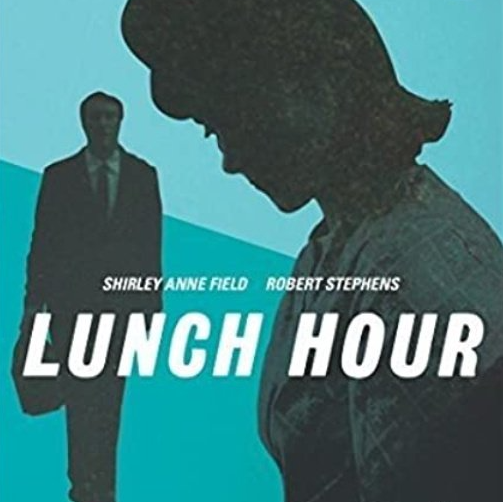Nutcracker
The Company of Mice

UK poster | Entertainment Film Distributors
1986 — USA
A HYPERION PICTURES/KUSHNER-LOCKE production, presented by THOMAS COLEMAN & MICHAEL ROSENBLATT
Cast: The PACIFIC NORTHWEST BALLET, with the voice of JULIE HARRIS
Director: CARROLL BALLARD
Producers: WILLARD CARROLL, DONALD KUSHNER, PETER LOCKE and THOMAS L. WILHITE
Executive Producers: THOMAS COLEMAN and MICHAEL ROSENBLATT
Conceived by: KENT STOWELL and MAURICE SENDAK
Original work by: E.T.A. HOFFMANN
Editors: JOHN NUTT and MICHAEL SILVERS
Cinematography: STEPHEN H. BURUM
Production and Costume designs: MAURICE SENDAK
Music: PETER ILYICH TCHAIKOVSKY
Performed by: The LONDON SYMPHONY ORCHESTRA, as conducted by Sir CHARLES MACKERRAS
Choreography: KENT STOWELL
Motion picture © Atlantic Entertainment Group
Choreography © Kent Stowell
Sets & Costumes © Maurice Sendak
Clara (Vanessa Sharp) dreams of a handsome princely type, but she also dreams that her little shit of a brother (Russell Burnett) will ruin the whole damn thing and have her get mauled by a mouse. Ah, well. At her parents’ Christmas party, her creepy as hell godfather; the master toymaker, horologist and rat catcher (what a combo) Drosselmeier (Hugh Bigney); arrives bearing gifts for all the chilluns. She’s simultaneously fascinated and repulsed by him, and all the other children pounce upon the sack of toys like hungry wolves leaving her with naught. Ah, well. A nutcracker falls from the Christmas tree and she takes that instead, but her brother soon grabs it and smashes it with a toy sword. Drosselmeier fixes it for her, but quickly takes it away for a dance. In the dead of night, after everyone has left, Clara goes down to the parlour to retrieve the nutcracker. As the clock strikes, everything in the room appears to grow larger around her. Taken aback, she steps on the tail a mouse having a picnic with its family in the middle of the floor. Its mother is most displeased. It’s an act of war, and soon an army of mice arrive on the scene, led by their multi-headed king.
The Nutcracker seems to be rather divisive as ballets go. This largely tends to stem a combination of it being firstly the most stereotypical ballet imaginable (if someone brings up ballet in abstract, you’re probably either going to think of this or Swan Lake), done to death and killed with passion, except perhaps for the passion bit, as well as secondly its plot or lack thereof. The actual story is all wrapped up by the end of the first act, the second consisting purely of dances with no real plot or connection to anything that happened before. It just exists to be pretty. On the whole, it all just evokes basically everything ballet can be derided as being.
Maurice Sendak was reportedly one of these people who fell on the side of The Nutcracker being a bit crap, but the Seattle-based Pacific Northwest Ballet convinced him to design a production of it for them in the early ‘80s anyway. The idea being that they would try and skew closer to the original source story by E.T.A. Hoffmann. You know, given the ballet’s reputation, it seems kind of weird that it’s based on a Hoffmann story, then again Coppélia pretty much completely misses the point of ‘The Sandman’, so… it at least fared better than that in its ballet adaptation, managing to recognisably convey the events of the original story, up to a point, at any rate, as the first act lines up reasonably with the first five chapters of the original story. That is, however, less than half of it, with the bulk of the remainder going out the window. Sendak was reportedly not impressed by the lack of a coherent plot between the two acts and sought to resolve it, though the bid to try and marry the two halves into a cohesive whole here doesn’t quite work out.
In terms of how it all differs from the archetypal production, well… in terms of the actual basic text, not exactly that much. It seeds the shift in the second act a bit, with the first act featuring iconography that comes to prominence later on, but it still ultimately just becomes dances with little in the way of plot, or overt plot, at any rate. It just changes the context of it a little; the candyland motif is ditched, but the dubious orientalism remains, and one could argue is exacerbated. As for going back to the original text, here are allusions to parts of Hoffmann’s story that don’t make the cut typically scattered throughout, though how likely you are to notice them as such if you’re not familiar with said story, I have to wonder. The most obvious of these is Clara dreaming of being turned into some hideous creature by a mouse bite, which echoes the Hoffmann’s backstory section with Princess Pirlipat, though there are a few other nods to it as well.†
While at its most basic, the plot hasn’t changed all that much, the dream element is one of the key parts of the film. Sendak’s (arguable) best known works, his ‘trilogy’; Where the Wild Things Are (1963), In the Night Kitchen (1970) and Outside Over There (1981); focus heavily on dreams, imagination and symbolism, with a theme of the various stages of children’s psychological development. His take on The Nutcracker kind of follows in these footsteps. Those three books ostensibly concern pre-school children, toddlers and pre-adolescents respectively. Nutcracker has more of an adolescent focus however. Clara is recast as an older child (the narration, presumably added for the film, claims her to be “nearly thirteen years old”), and the whole thing is struck through with an age-appropriate sense of her confusion and conflict over events that transpiring as reality and dreams come to bleed together. What I’m getting at here is that there’s a sexual awakening motif lurking in the background; the film belongs to the same subset of films as things like Valerie and Her Week of Wonders (1970), The Company of Wolves (1984) or The Magic Toyshop (1987), which similarly feature dreams and reality mixing in vaguely gothic metaphors for female adolescence. It’s obviously a bit more family friendly that any of those, mind you. The recurring iconography in the second act cements its fantasy status in a way that has the metaphorical take on a more literal significance in Clara’s mind. One of these involves recurrence of cast members in different roles; aside from the replacement of the child Clara with a (adult) ballerina doll (Patricia Barker) of Drosselmeier’s which she admires in the first act, the most obvious is that the Pasha at the clockwork palace in second act being portrayed by the same performer as Drosselmeier, a rather ambiguously sinister figure that apparently demands her affections all to himself. The other more subtle but perhaps most noteworthy one is the recasting of her mother (Maia Rosal) as a bird in a literal gilded cage, trotted out to perform for the court’s amusement before being locked away again.
The original production of the ballet was apparently very successful and remained part of the company’s repertoire until 2014, at which point it was retired in favour of a production based on George Balanchine’s choreography (though they got another children’s book illustrator to do the designs). While presumably the more psychological edge had something to do with it as well, one imagines that part of its enduring appeal was its stellar production design. While I believe parts of said design have been tweaked or changed for the film version in order to take more advantage of the medium, it maintains a distinct story book appeal, with a peculiar delineation between the ordinary and the fantastic, with the fantasy sequences taking on a sort of artifice reminiscent of Powell and Pressburger’s later work, in particular, conveniently enough, The Tales of Hoffmann (1951). While the film, and presumably the stage production on which it’s based, does not always succeed in what it seeks to do, it nonetheless has a distinct appeal and avoids much of the tweeness that’s often associated with the story… or the medium in general.
† After the usual bit of the story, there’s a section where Drosselmeier explains the apparent origin of the nutcracker. It involves the queen of mice taking revenge on a family of royals. I assume most people aren’t familiar, so I’ll give you the gist (though the thing is in the public domain, so really you could track it down fairly easily): Many moons ago, the (human) queen gave some of the fat from the sausages to the mouse queen at her request, but her greedy family came out of the woodwork and made off with most of it. Bitchy that his sausages aren’t fatty enough, the king orders the mice in the palace all be destroyed, tasking the mechanist Drosselmeier (surely a coincidence) with achieving it. He proceeds to off most of the mouse royal family, and the mouse queen vows revenge, with involves biting the princess and turning her into a monstrosity (read: a nutcracker). The king demands his daughter be fixed, it all gets slightly body horror-ish for a bit, and then Drosselmeier finds that the curse can be cured via a ritual involving cracking the world’s hardest nut, and sets off travelling the world to find said nut and someone to perform the ritual. Quite a while later, it turns out that not only does his brother have one, but his nephew has unfeasibly strong teeth. While performing the ritual however, he steps on the mouse queen killing her and falls over as a result. It all works out in a manner where the princess is restored, but he gets cursed instead. The princess won’t marry him now that he’s an uggo, and also the mouse queen’s heir is out to avenge her death at his hand (or foot). As I say, some elements of this are worked into this version of the ballet, though not necessarily to the same result.
At time of writing, Nutcracker is available to rent off of Amazon, Youtube and Apple TV, amongst other services. I recommend JustWatch for keeping up with where films are streaming (including this one!). Alternatively, physical copies are reportedly available for rent via Cinema Paradiso.
The film presently has a U rating (last being submitted in 1987). This naturally predates the period where the BBFC give details on the website; that said, the most recent (at time of writing) video release was apparently willing to put it out with the seldom seen E pseudo-rating, so that should suggest how little there is to get worked up about. (Though it's kind of weird that they did that when the film already has a BBFC rating.) With that said,
The Nutcracker has a dubious history with ethnic and racial stereotypes, and honestly they haven't been sorted out here.
Sources
Darnton, N., 1986. ''Nutcracker' Film Designer Was Relectant', Sun-Sentinel, [online]. Available at: <https://web.archive.org/web/20160304062814/http://articles.sun-sentinel.com/1986-12-07/features/8603150128_1_ballet-nutcracker-film> [Accessed 18 December 2021]. Archived from the original.
D'Avila, F., 2014. 'In Seattle, Maurice Sendak's 'Wild' 'Nutcracker' Reaches Its Final Act', NPR, [online]. Available at: <https://www.npr.org/2014/12/23/371254489/in-seattle-maurice-sendaks-wild-nutcracker-reaches-its-final-act?t=1640227307133> [Accessed 23 December 2021].
Zakariasen, B., 1986. ''Nutcracker' Filming Involved Artistic, Directorial Challenge', Sun-Sentinel, [online]. Available at: <https://web.archive.org/web/20160303222708/http://articles.sun-sentinel.com/1986-12-09/features/8603150545_1_nutcrackers-i-ve-kent-stowell-ballet> [Accessed 6 April 2021]. Archived from the original.



